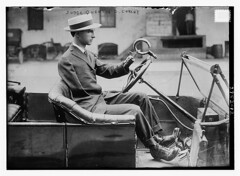
Judge Quentin D. Corley (LOC)
Originally uploaded by The Library of Congress
Another disability history image thanks to the Flickr Commons project. This one is from the Library of Congress's set from the George Grantham Bain Collection, news photos from 1910-1915. Here we see Judge Quentin D. Corley (as the title suggests), driving a very early model car with steering wheel adaptations for his prosthetic left hand; the right sleeve of his jacket appears to be empty. Corley looks to be a young man wearing a white summer hat.
Quentin Durward Corley was born in 1884 in Mexia, Texas. As a young clerk in 1905, he lost both hands, his right arm, and his right shoulder in a railroad accident near Utica, New York. Corley went into a law career, passing the bar in Dallas County in 1907; in 1908 he became a justice of the peace, and in 1912 he was elected a county judge--the youngest county judge in Texas at the time. He also developed and patented the prosthetic hand he's shown using here--which allowed him to drive, type, button, cut, light a match, and write with a pen better than other available options. He toured the state of Texas alone by car to publicize his campaign for a girls' training school in the state. Corley died in 1980, age 96.
The Dallas Observer's blog wrote up this photo last fall. But they refer to a much earlier newspaper's treatment of the story: in 1918, under the title "Handicaps of Fate Defied by Cripples," the New York Times reported that Corley spoke a meeting at the then-new Red Cross Institute for Crippled and Disabled Men in New York City that year, intended to encourage returning World War I veterans who may have similar physical impairments. Other speakers at the meeting were Michael J. Dowling, a bank president from Olivia, Minnesota (and a triple amputee from severe frostbite in his youth); and Frederick W. Keough, a representative of the National Association of Manufacturers, who discussed the issues of rehabilitation and employment for disabled veterans.
10 comments:
Post a Comment